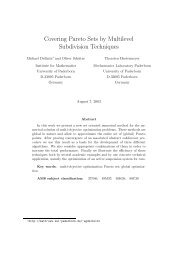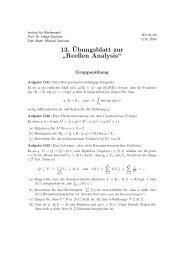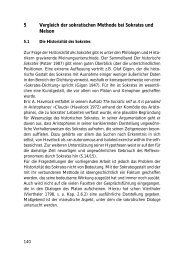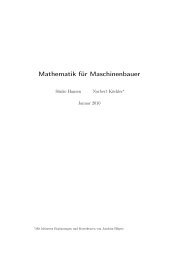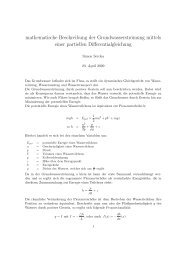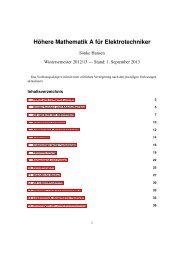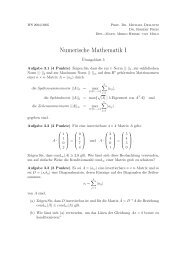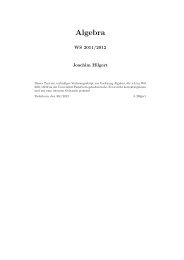Partial Differential Equations
Partial Differential Equations
Partial Differential Equations
Create successful ePaper yourself
Turn your PDF publications into a flip-book with our unique Google optimized e-Paper software.
1.2 The Laplace Equation 7<br />
Proof. Idea: Integrate in polar coordinates<br />
Integration in polar coordinates shows that it suffices to prove the convergence of the integrals<br />
∫ R<br />
0<br />
(log r)r dr<br />
and<br />
∫ R<br />
0<br />
1<br />
r n−2 rn−1 dr.<br />
The latter is trivial, and for the integral ∫ R<br />
(log r)r dr, it is enough to prove that r log r can continuously<br />
0<br />
be extended to [0, ∞[ by 0. To see this, we set r = e −t and take into account that lim t→∞ te −t = 0.<br />
1.25<br />
1<br />
0.75<br />
0.5<br />
0.25<br />
-0.25<br />
0.5 1 1.5 2<br />
Fig. 1.3. The function x log x<br />
With the fundamental solution Φ, every function x ↦→ cΦ(x − y) with fixed c ∈ R and y ∈ R n also is<br />
a solution of the Laplace equation, i.e. they are harmonic (in their definition domains). If f : R n → R is<br />
an arbitrary function, then every function x ↦→ Φ(x − y)f(y) is harmonic. Now, summation over several<br />
y suggests that the convolution<br />
∫<br />
u(x) := Φ(x − y)f(y)dy<br />
R n<br />
is a solution of the Laplace equation if the integral converges. By Lemma 1.2.4, it does converge if f is<br />
continuous with compact support, i.e. if f ∈ C c (R n ). But, the interchange of derivatives and integral is<br />
not justified. We rather have the following result.<br />
Theorem 1.2.5. Let f ∈ Cc 2 (R n ), and let<br />
{<br />
−<br />
1<br />
2π<br />
log |x| for n = 2,<br />
Φ(x) =<br />
1 1<br />
n(n−2)α(n) |x|<br />
for n ≥ 3.<br />
n−2<br />
Then, u(x) := ∫ R n Φ(x − y)f(y)dy defines a function in C 2 (R n ) which satisfies −∆u = f, i.e. it solves<br />
the Poisson equation with respect to f.<br />
Proof. Idea: Calculate the partial derivatives of u via the definition and use integration by parts to determine<br />
∆u. This can be done separating the singularity 0 by a sphere of radius ε.<br />
We already saw that u: R n → R is a well defined function. Since u(x) = ∫ Φ(y)f(x − y) dy, for the<br />
R n<br />
j-th unit vector e j = (0, . . . , 0, 1, 0, . . . , 0) ∈ R n and h ≠ 0, we have<br />
∫ ( )<br />
u(x + he j ) − u(x)<br />
f(x + hej − y) − f(x − y)<br />
= Φ(y)<br />
dy.<br />
h<br />
R h<br />
n<br />
By the Mean Value Theorem, one sees that f(x+hej−y)−f(x−y)<br />
h<br />
uniformly converges to ∂f<br />
∂x j<br />
(x − y) for<br />
h → 0 since the derivative is bounded. By dominated convergence, we get<br />
u(x + he j ) − u(x)<br />
lim<br />
=<br />
h→0 h<br />
∫<br />
R n Φ(y) ∂f<br />
∂x j<br />
(x − y) dy.<br />
Since the expression is continuous in x this shows the continuous differentiability of u and the formula




